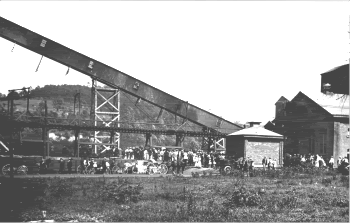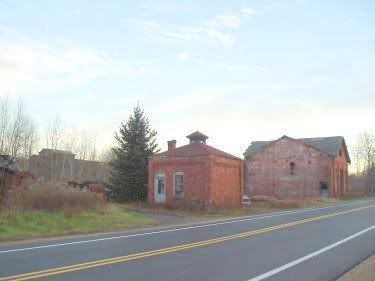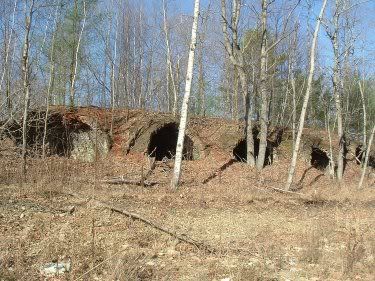The Ontario northwoods are full of ghosts. Its true. I have met them!!! No, not the ghoulie kind of chain rattling ghosts that you find hanging around old castles, but instead, ghosts of Ontarios recent past.
Walk with me, if you will, through an old logging road, filled with second growth timber large enough to discourage the four wheelers and the weekend explorers. There in the distance, vaguely seen through a curtain of Elderberry and Hazlebrush, you will see a line that simply doesnt occur in nature. On closer examination, you will first see the tops of a pair of four or six foot diameter flywheels, black and massive against the background. Then, a cement footing that sticks up above the ground by five or six foot , topped by a great iron casting that was once the heart and soul of a massive steam engine.
The remains of this collosus will be in what is left of a clearing. Probably there will be nothing else, save for the crankcase housing and cylinder, which were all cast as one unit, the flywheels and crankshaft, and perhaps a massive connecting rod, still in place. Everything else will be gone, either decayed and returned to the earth from whence it came, or carted off by opportunistic scavengers.
During the 1980s, I was involved in the engineering and development of high production sawmills. This consisted of redesigning old circular saw and carriage mills that were designed and built during the early 1950s to cut 20 white pine. Ripping out the old circular saws and putting in double cut bandsaws, ripping out doublecut bandsaws and installing gang saws, known as bull edgers. I was based out of Eganville in the heart of Ontarios Ottawa valley. My travels took me all through the Ontario northwoods, and I was amazed and awed by the remains of these old mills built during the mid to late 1800s.
Many of these early sawmills were built on water, generally at the end of a big lake, where a fast running exit stream could be damned and forced though a water turbine to generate power for the mills. Due to the proliferation of cottagers during the 1950s and afterwords, and the very accessability of these mills, there is absolutely nothing left to mark that mills were ever there. Such is the case in LAmable where I spent my childhood. You would never know it now, there is nothing left to see, but at the end of LAmable Lake, the Brown brothers had a water powered sawmill that ran all summer when I was a boy in the early 1950s. Contrary to what a lot of people now think, these water powered mills did not run on a waterwheel. A waterwheel simply didnt generate sufficient power to run a 54 mainsaw thru a 20 white pine log. Instead, most of the early sawmills ran on a patented water turbine that generated about 3 times as much torque as any waterwheel ever produced. Waterwheels were used mainly for grinding grain and corn into flour---grist mills.
The forest ghosts that I write about in this story were mills that were built where there was an abundance of big timber, but no watercourse to be damned for power. The steam engines would be shipped in by horse drawn sleighs in the wintertime, after the ground has frozen hard enough to support the massive sleighs, often drawn by 3 teams of horses in a tandem hitch.---There were no roads as we know them now. The mills would be built around the steam engine and would run untill either the area was logged out, or more frequently untill the mill burned down. If there was still a lot of good timber to be had in the area, the mill would be rebuilt after it burned----if the area was logged out, then the mill was abandoned. Everything that could be salvaged and moved was taken away, but generally the main engine (these were not portable steam engines) was left behind.
I dont know if it is still there or not, but there used to be a big old engine like that at the foot of the hill in Wilno, Ontario, on the highway heading north towards Barrys Bay from Bancroft.---There was another one on the access road to Kinesis Lake near Haliburton.---and many more that I have seen, in little places that no longer even have names, nor any human habitation for miles around.
Walk into the overgrown clearing with me. Close your eyes for a moment. Feel the hot sun on your face, and hear the call of a bluejay.----and listen. Listen really hard, and if you are one of the fortunate perhaps you will hear the scream of the mainsaw as it bites into a knot in a big old pine---the ratchet and clack of the carriage as it is dogged over another six quarters for the next pass. Smell the pine pitch and the sweet smell of fresh sawn lumber. Maybe even a hint of smoke from the sawdust pile, which was always on fire at some level and could never be totally extinguished.---Maybe you will even hear the shriek of the steam whistle, which signalled starting time, lunch break, and end of the days work.
Yes, there are ghosts in the northwoods. And those ghosts touch my heart on a level that even I find hard to understand. May I always carry those ghosts with me, and feel just a touch of sadness for the times that are gone forever, and a generation of young people growing up now that know there are no such thing as ghosts.
Brian Rupnow---March-2009
Walk with me, if you will, through an old logging road, filled with second growth timber large enough to discourage the four wheelers and the weekend explorers. There in the distance, vaguely seen through a curtain of Elderberry and Hazlebrush, you will see a line that simply doesnt occur in nature. On closer examination, you will first see the tops of a pair of four or six foot diameter flywheels, black and massive against the background. Then, a cement footing that sticks up above the ground by five or six foot , topped by a great iron casting that was once the heart and soul of a massive steam engine.
The remains of this collosus will be in what is left of a clearing. Probably there will be nothing else, save for the crankcase housing and cylinder, which were all cast as one unit, the flywheels and crankshaft, and perhaps a massive connecting rod, still in place. Everything else will be gone, either decayed and returned to the earth from whence it came, or carted off by opportunistic scavengers.
During the 1980s, I was involved in the engineering and development of high production sawmills. This consisted of redesigning old circular saw and carriage mills that were designed and built during the early 1950s to cut 20 white pine. Ripping out the old circular saws and putting in double cut bandsaws, ripping out doublecut bandsaws and installing gang saws, known as bull edgers. I was based out of Eganville in the heart of Ontarios Ottawa valley. My travels took me all through the Ontario northwoods, and I was amazed and awed by the remains of these old mills built during the mid to late 1800s.
Many of these early sawmills were built on water, generally at the end of a big lake, where a fast running exit stream could be damned and forced though a water turbine to generate power for the mills. Due to the proliferation of cottagers during the 1950s and afterwords, and the very accessability of these mills, there is absolutely nothing left to mark that mills were ever there. Such is the case in LAmable where I spent my childhood. You would never know it now, there is nothing left to see, but at the end of LAmable Lake, the Brown brothers had a water powered sawmill that ran all summer when I was a boy in the early 1950s. Contrary to what a lot of people now think, these water powered mills did not run on a waterwheel. A waterwheel simply didnt generate sufficient power to run a 54 mainsaw thru a 20 white pine log. Instead, most of the early sawmills ran on a patented water turbine that generated about 3 times as much torque as any waterwheel ever produced. Waterwheels were used mainly for grinding grain and corn into flour---grist mills.
The forest ghosts that I write about in this story were mills that were built where there was an abundance of big timber, but no watercourse to be damned for power. The steam engines would be shipped in by horse drawn sleighs in the wintertime, after the ground has frozen hard enough to support the massive sleighs, often drawn by 3 teams of horses in a tandem hitch.---There were no roads as we know them now. The mills would be built around the steam engine and would run untill either the area was logged out, or more frequently untill the mill burned down. If there was still a lot of good timber to be had in the area, the mill would be rebuilt after it burned----if the area was logged out, then the mill was abandoned. Everything that could be salvaged and moved was taken away, but generally the main engine (these were not portable steam engines) was left behind.
I dont know if it is still there or not, but there used to be a big old engine like that at the foot of the hill in Wilno, Ontario, on the highway heading north towards Barrys Bay from Bancroft.---There was another one on the access road to Kinesis Lake near Haliburton.---and many more that I have seen, in little places that no longer even have names, nor any human habitation for miles around.
Walk into the overgrown clearing with me. Close your eyes for a moment. Feel the hot sun on your face, and hear the call of a bluejay.----and listen. Listen really hard, and if you are one of the fortunate perhaps you will hear the scream of the mainsaw as it bites into a knot in a big old pine---the ratchet and clack of the carriage as it is dogged over another six quarters for the next pass. Smell the pine pitch and the sweet smell of fresh sawn lumber. Maybe even a hint of smoke from the sawdust pile, which was always on fire at some level and could never be totally extinguished.---Maybe you will even hear the shriek of the steam whistle, which signalled starting time, lunch break, and end of the days work.
Yes, there are ghosts in the northwoods. And those ghosts touch my heart on a level that even I find hard to understand. May I always carry those ghosts with me, and feel just a touch of sadness for the times that are gone forever, and a generation of young people growing up now that know there are no such thing as ghosts.
Brian Rupnow---March-2009


































































